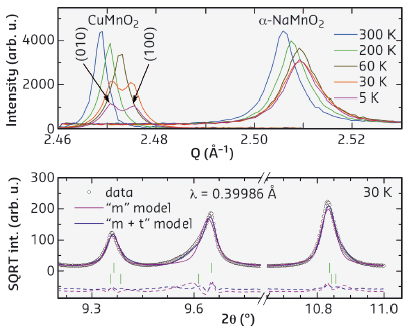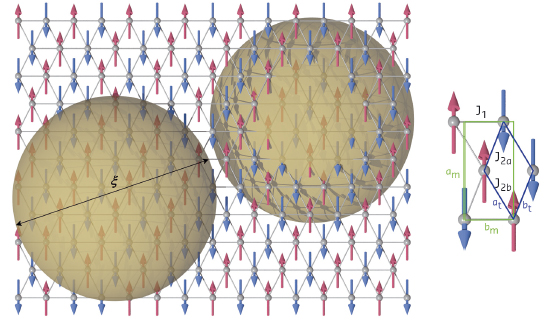- Home
- Users & Science
- Scientific Documentation
- ESRF Highlights
- ESRF Highlights 2014
- Structure of materials
- On the inhomogeneous ground state of a triangular antiferromagnet
On the inhomogeneous ground state of a triangular antiferromagnet
In condensed matter, phase separation breaking the translational symmetry of a Hamiltonian on a local scale is particularly intriguing, as it regularly appears in chemically homogeneous systems [1]. This is related to some fundamental functional properties of materials, such as colossal magnetoresistance of manganites, giant electrostriction of relaxors, and possibly even high-Tc superconductivity [1]. According to a conventional paradigm, electronic charge plays the leading role in promoting phase-separated states when competing phases are present. Also, quenched disorder – random deviations from perfect system’s uniformity – is generally required for the stabilisation of such states. However, in spin systems that are geometrically frustrated, a novel mechanism leading to spatial instabilities could be at play even in the absence of charge degrees of freedom and in the clean limit. In such spin lattices, geometrical constraints prefer exotic degenerate ground states over conventionally ordered magnetic states. We have identified a novel kind of phase-separated state in the triangular antiferromagnet α-NaMnO2, where the interplay of geometrical frustration and a structural instability of the lattice leads to a magnetostructural inhomogeneity at the nanoscale.
The investigated compound α-NaMnO2 is well known for its intriguing magnetic and structural properties [2]. It orders magnetically at TN = 45 K, but diffuse neutron magnetic scattering, characteristic of short-range spin correlations, remains present down to the lowest temperatures. The coexistence of such scattering with sharp magnetic Bragg peaks is a clear indication of a magnetically inhomogeneous ground state intrinsic to α-NaMnO2. Moreover, large and highly anisotropic microstrains in the crystal structure above TN suggest structural inhomogeneities. Based on the analysis of the neutron powder diffraction patterns, the microstrains were reported to grow with decreasing temperature that should eventually result in a monoclinic-to-triclinic structural phase transition, occurring simultaneously with the magnetic ordering [2].
 |
|
Fig. 138: Upper panel: Bragg-peak splitting witnesses the presence (CuMnO2) and absence (α-NaMnO2) of a structural phase transition. Lower panel: Rietveld fit of the synchrotron X-ray powder diffraction (XRD) profile of α-NaMnO2 in the inhomogeneous phase, with the monoclinic (“m”) only and a combined monoclinic and triclinic (“m + t”) models. |
We have studied the alleged structural changes in α-NaMnO2 at beamline ID31 (now ID22). The enhanced resolution of the synchrotron X-ray diffraction compared to previous neutron studies has revealed that a bulk structural transition is impeded, in sharp contrast to the isostructural CuMnO2 compound, where such magnetic-order-induced improper ferroelastic transition indeed occurs at TN = 65 K (Figure 138). A characteristic symmetry-lowering peak splitting is missing in α-NaMnO2, although the reflections exhibit sizeable anisotropic broadening with decreasing temperature (Figure 138). Moreover, a peculiar asymmetric line shape developed below TN that cannot be adequately modelled by the high-temperature monoclinic crystal structure (Figure 138). Regularly observed structural defects, such as twin boundaries and stacking faults, fail to account for the measured peak-shapes. Therefore, a more complex parameterisation of the structural model was required. A two-phase model incorporating the monoclinic and triclinic phase offers a significantly improved Rietveld refinement (Figure 138). This implies the presence of randomly distributed nanoscale inhomogeneities, pertaining to the minority triclinic phase that grows at the expense of the majority monoclinic phase.
 |
|
Fig. 139: Left: Illustration of the magnetostructurally inhomogeneous ground state of α-NaMnO2. Right: Local structural deformation from the monoclinic (m) to triclinic (t) symmetry pertinent to the defect (sphere) regions. |
Such a nanoscale structural inhomogeneity is further supported by an electronic inhomogeneity. The latter has been witnessed in α-NaMnO2 by our local-probe magnetic investigations, incorporating both nuclear magnetic resonance (NMR) and muon spin relaxation (mSR) techniques. These have unambiguously demonstrated a nanoscopic coexistence of two different magnetic environments that can be explained by a model of triclinic magnetic defects in the form of dispersed nano-sized islands, with the magnetic order reversed at the interfaces with the monoclinic matrix (Figure 139).
We suggest that the newly discovered magnetostructural phase separation in α-NaMnO2 is a consequence of the system’s tendency to remove magnetic degeneracy associated with the geometrically frustrated triangular spin lattice (Figure 139). The associated magnetic-exchange energy gain due to the monoclinic-to-triclinic distortion is compensated by the increase of the elastic energy. The resulting near-degenerate monoclinic and triclinic structures, as suggested by ab initio calculations, can then lead to nanoscale phase separation even in the limit of zero quenched disorder.
Principal publication and authors
A. Zorko (a, b) O. Adamopoulos (c), M. Komelj (a), D. Ar?on (a, d) and A. Lappas (c), Nat. Commun. 5, 3222 (2014).
(a) Jožef Stefan Institute, Ljubljana (Slovenia)
(b) EN—FIST Centre of Excellence, Ljubljana (Slovenia)
(c) Institute of Electronic Structure and Laser, Foundation for Research and Technology—Hellas, Heraklion (Greece)
(d) Faculty of Mathematics and Physics, University of Ljubljana (Slovenia)
References
[1] E. Dagotto, Science 309, 257–262 (2005).
[2] M. Giot et al., Phys. Rev. Lett. 99, 247211 (2007).



